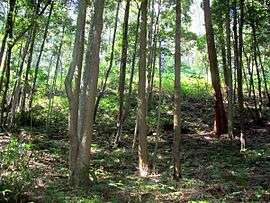Garawarra State Conservation Area
The Garawarra State Conservation Area is a protected conservation area that is located on the southern suburban fringe of Greater Sydney, in the state of New South Wales, in eastern Australia. The 949-hectare (2,350-acre) reserve abuts the Royal National Park and is situated 40 kilometres (25 mi) south of the Sydney central business district, near Helensburgh. Garawarra was gazetted as a park in 1987,[1] and added, together with the Royal National Park, to the Australian National Heritage List on 15 September 2006.[2]
| Garawarra State Conservation Area New South Wales | |
|---|---|
 Camp Gully Rainforest with Sassafras in the conservation area | |
 Garawarra State Conservation Area | |
| Nearest town or city | Helensburgh |
| Coordinates | 34°11.11′S 151°00.366′E |
| Established | December 1987[1] |
| Area | 9.49 km2 (3.7 sq mi)[1] |
| Managing authorities | NSW National Parks and Wildlife Service |
| Website | Garawarra State Conservation Area |
Garawarra features heathland, eucalyptus forest, rainforest and wildflowers in late winter and early spring. Commonly seen wildlife include the Lyrebird and Echidna.[1] The soils are based on Hawkesbury Sandstone and the Narrabeen group of sedimentary rocks. The climate is humid and temperate, with warm summers and mild winters. Rainfall is spread throughout the year, being in excess of 1,000 millimetres (39 in).
Features

Flora
Dry heathland on the ridges is dominated by typical Sydney sandstone plants, such as Banksia, Boronia, Leptospermum, Epacris, Acacia, Flannel Flowers, Christmas Bells, and many plants in the pea family. The drier eucalyptus woodland features trees species such as Sydney Red Gum, dwarf apple, Red Bloodwood, Yellow Bloodwood, and Sydney Peppermint.[3]
The wet sclerophyll forests have many large trees over 30 metres (98 ft) tall. Significant species include Blackbutt, Sydney Blue Gum, Turpentine and Grey Ironbark.[3]
At first appearance, the warm temperate rainforests seem typical of the northern Illawarra. Warm temperate species such as Sassafras and Jackwood are common. However, the rainforests are quite diverse with many interesting sub-tropical species. Such as Small-leaved Fig, Bollygum, White Hazelwood, Brush Bloodwood, Citronella, Native Tamarind and Myrtle Ebony.[4]
Fauna
The area has a rich assembly of rainforest birds, as well as a variety of frogs and reptiles.[2]
References
- "Garawarra State Conservation Area: Park management". Office of Environment and Heritage. Government of New South Wales. Retrieved 21 September 2014.
- "Royal National Park and Garawarra State Conservation Area". Department of Sustainability, Environment, Water, Population and Communities. Australian Government. 15 May 2008. Retrieved 6 April 2011.
- "Garawarra State Conservation Area: Plants, animals and landscape". Office of Environment and Heritage. Government of New South Wales. Retrieved 10 April 2011.
- "A. Bofeldt, Camp Gully Species List". 2000. Archived from the original on 6 April 2011. Retrieved 10 April 2011.
External links
- "Amendments to the Royal National Park, Heathcote National Park and Garawarra State Conservation Area: Plan of management" (PDF). NSW National Parks and Wildlife Service (PDF). Government of New South Wales. September 2010. ISBN 978-1-74232-956-7.
- "Royal National Park, Heathcote National Park and Garawarra State Conservation Area: Plan of management" (PDF). NSW National Parks and Wildlife Service (PDF). Government of New South Wales. February 2000. ISBN 0-7310-0895-2.